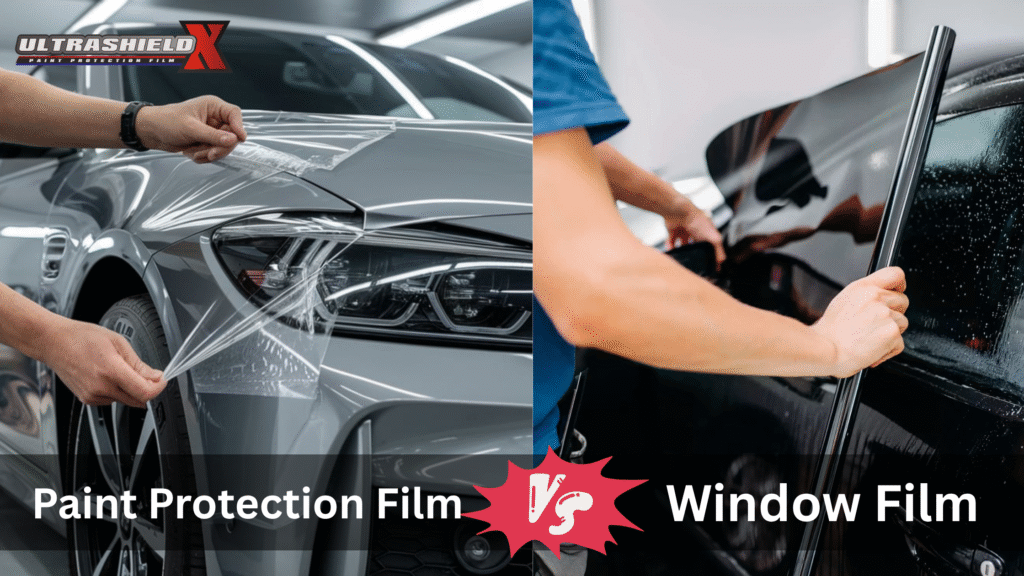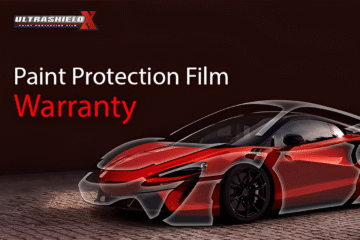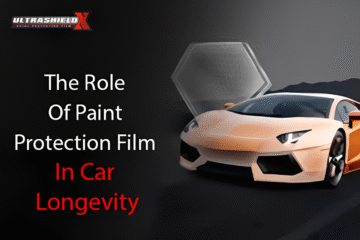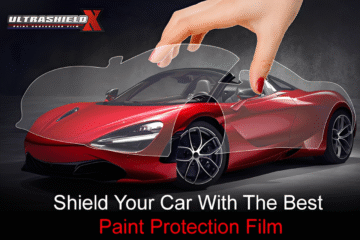If you are a true car lover who has spent years obsessing over detailing and preservation, you might have definitely come up with the question of ultimate protection for your vehicle, which is paint protection film vs window film.
It’s completely understandable why people mix them up. They’re both transparent coatings that are applied to your vehicle. But trust me, assuming paint protection film vs window film is the same is like wearing a raincoat when you actually need a helmet. They guard against wildly different things.
Let’s cut through the confusion and examine why these two products are the perfect pair for your vehicle.

What is Paint Protection Film Really For?
Forget wax and start thinking of paint protection film as a second skin for your car’s exterior. It’s a robust, thick layer of urethane applied to the body panels, hood, bumper, fenders, and the parts that face the road’s worst abuse.
The core job of this PPF film for car owners is physical damage control. When a rock chip flies up on the freeway, when abrasive road salt is kicked up, or when a shopping cart bumps your fender, the PPF coating is the armor. It takes the hit, preventing a scratch or chip from reaching your expensive factory paint.
What sells me on it? The self-healing capability. Those annoying, fine swirl marks and light scratches that appear from washing or daily driving often vanish when the film gets warm. If maintaining that perfect, deep gloss is your goal, getting paint protection film for car is the only way to go.
What is Window Film (Tint)? Does It Only Provide Privacy?
Window film (better known as car window tinting), and there is no direct relation to the PPF. This film goes on the inside of your windows, and its mission is entirely about cabin environment control and comfort.
While tinted windows absolutely give you privacy and a sharp look, the serious benefits of a premium car window film are functional:
- Heat Defense: High-quality films, especially a ceramic window tint, are scientifically engineered to reject massive amounts of solar heat. Result? Your car stays cool, you use less AC, and your drive is way more pleasant.
- Saving Your Interior and Health: It’s a UV protection window film. It blocks up to 99% of damaging UV rays. This stops your dashboard from cracking, your leather from fading, and crucially protects you and your passengers from sun exposure.
- Clarity and Safety: Quality automotive window tint reduces sun glare and those blinding nighttime headlights, making the entire act of driving safer and less fatiguing.
Whether you’re after the best window tinting job or a clean window tint removal, the product is all about making the interior better.
5 Common Myths About PPF and Window Tint
Seriously, after years in this industry, the same handful of misunderstandings about paint protection film and window film (your tint) pop up every single day. Let’s set the record straight right now, speaking car owner to car owner:
Myth 1 – Their work is the same
Absolutely not. This is the biggest mistake people make. Think of it in this way, as the PPF is your car’s bodyguard. It’s there for the physical fight from rock chips, the scratches, the road salt.
Window film is your car’s sunscreen. It’s fighting the invisible war against UV rays and heat. Their jobs are completely different.
Myth 2 – Window tint also safeguards your vehicle’s paint
That film is doing an amazing job protecting your leather seats and your skin. But it has zero ability to stop a pebble from flying up and chipping your hood. If you want to protect your vehicle’s paint, you have to put the paint protection film on your vehicle’s surface.
Myth 3 – PPF assists in keeping my car cool
Paint protection film is designed to absorb impact, not to absorb thermal energy. While it’s covering your car, it doesn’t have the specialised ceramic or metallic particles that window film uses to actually reject heat and infrared light. If you want a cool cabin and fade-free dash, you still need that quality window tint.
Myth 4 – They are made up of the same clear material
They are totally different materials! PPF is a thick, stretchy, super-durable urethane, and it needs to flex and self-heal.
Window film is a much thinner, highly sophisticated, layered polyester material that has been engineered specifically for solar performance. The chemistry is totally different because the missions are totally different.
Myth 5 – I can only get one thing done at my car
Sure, but you’re leaving half your car exposed! Choosing only PPF means you’ll still feel the heat and see your interior fade. Choosing only
Window film means you’ll still get chips and scratches on your paint. To truly preserve your investment, these two are an unbreakable team, as one is for the exterior and the other one for the interior. Don’t settle for half-protection!
Why Do I Need Both? The Truth About PPF vs Window Film
Here’s the bottom line: they are an essential pair because they protect completely separate areas from completely different threats.
| Feature | Paint Protection Film | Window Film |
| Protects | The paint finish and exterior body panels | The interior (dash, seats) and the occupants |
| Fights Against | Physical trauma (rock chips, scratches) | Environmental trauma (UV rays, intense heat, glare) |
| Simple Name | PPF | SunFilm |
| Where It Goes | ON THE PAINT—applied to the outside body of the car (hood, bumper, fenders). | ON THE GLASS—applied to the inside of the windows. |
| What It Does | It’s a physical shield. Its job is to absorb impacts and prevent scratches. | It’s a filter and reflector. Its job is to manage light and heat. |
| Its Enemy | Physical Stuff: Rock chips, road salt, bug guts, small scrapes. | Invisible Stuff: UV rays, scorching heat, blinding glare. |
| The “Wow” Factor | It self-heals—light scratches disappear with heat! | It keeps your cabin cool, so you’re not baking in traffic! |
| What People Call It | PPF film, PPF coating | Window tint, ceramic window tint |
| The Bottom Line | You need it to keep your paint finish looking flawless and protect resale value. | You need it to keep your interior from fading and make your drive comfortable. |
The toughest PPF on your fender won’t stop the sun from roasting your leather seats. And the finest car window film can’t prevent a flying pebble from chipping your hood. To achieve true, complete, long-term preservation of your vehicle’s value, you need both films to get the complete protection.
Conclusion
By now, we hope that you might have understood the paint protection film vs window film differentiation. So now, when you decide to give your vehicle the protection it truly deserves, work with a brand that excels in both films with the provided knowledge. We confidently recommend UltrashieldX for their professional-grade paint protection film and advanced ceramic window tint solutions. As you don’t protect your car halfway and get it done seamlessly, a full-coverage protection, inside and out. So call UltrashieldX at +91-80-100-44000 to get it done by professional hands and also for expert consultation today.
FAQs
Q1. Which one is better, paint protection film or a wrap?
The answer is, of course, a paint protection film, as it provides a higher level of safeguarding to your vehicle, such as preventing fading, oxidation, chemical stains, bird droppings, minor scratches, and much more, whereas a wrap is a thin film that transforms the color of your vehicle and provides a new finish and aesthetic.
Q2. Which is more better option to get a PPF or ceramic coating?
Both of these automobile detailing services have their own advantages that they provide, like better protection, like a shield, then you should opt for PPF, and for enhancing gloss, and in making the cleaning process easy.
Q3. Is window film illegal in India?
Yes, it is as most of the window tints and even a few window films are darker, which goes against the Central Motor Vehicles Rules (CMVR), but you can go with UltrashieldX window film, as it abides by the laws of 70% VLT for the windshield and 50% VLT for side windows.
Q4. How much can a PPF coating cost?
A PPF coating of UltrashieldX starts from basic ₹1,20,000 and goes up to 3,36,000 as a good quality paint protection film does cost so but it lasts with your vehicle for years.
Q5. Which PPF brand is the best?
UltrashieldX is the best PPF brand in India for your vehicle as it is made up of Thermoplastic Polyurethane (TPU), its raw material is sourced from prominent BASF, Mitsui, Wanhua, Covestro, and Lubrizol. The adhesive used in the last layer is from Ashland.
Q6. Can you wax a PPF coated car?
Yes, you can wax or apply a sealant on top of a PPF coated car, but just that you do require the correct and authentic products for the proper outcome.



0 Comments